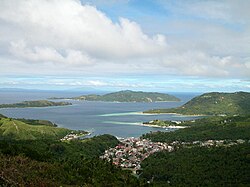Romblon
| Romblon | |||||||||
|---|---|---|---|---|---|---|---|---|---|
| Province | |||||||||
| Province of Romblon | |||||||||
(From top, left to right)
|
|||||||||
|
|||||||||
| Nickname(s): Marble Capital of the Philippines | |||||||||
 Location in the Philippines |
|||||||||
| Coordinates: 12°33′N 122°17′E / 12.55°N 122.28°ECoordinates: 12°33′N 122°17′E / 12.55°N 122.28°E | |||||||||
| Country | Philippines | ||||||||
| Region | Mimaropa (Region IV-B) | ||||||||
| Founded | March 16, 1901 | ||||||||
| Capital | Romblon | ||||||||
| Government | |||||||||
| • Type | Sangguniang Panlalawigan | ||||||||
| • Governor | Eduardo C. Firmalo (Liberal) | ||||||||
| • Vice Governor | Jose Riano (Liberal) | ||||||||
| • Representative | Emmanuel F. Madrona (Nacionalista) Lone District |
||||||||
| Area | |||||||||
| • Total | 1,533.45 km2 (592.07 sq mi) | ||||||||
| Area rank | 68th out of 81 | ||||||||
| Highest elevation (Mount Guiting-Guiting) | 2,058 m (6,752 ft) | ||||||||
| Population (2015 census) | |||||||||
| • Total | 292,781 | ||||||||
| • Rank | 66th out of 81 | ||||||||
| • Density | 190/km2 (490/sq mi) | ||||||||
| • Density rank | 46th out of 81 | ||||||||
| Divisions | |||||||||
| • Independent cities | 0 | ||||||||
| • Component cities | 0 | ||||||||
| • Municipalities |
17
|
||||||||
| • Barangays | 219 | ||||||||
| • Districts | Lone district of Romblon | ||||||||
| Time zone | PHT (UTC+8) | ||||||||
| ZIP Code | 5500–5515 | ||||||||
| IDD : area code | +63 (0)42 | ||||||||
| ISO 3166 code | PH-ROM | ||||||||
| Spoken languages | |||||||||
| Website | www |
||||||||
Romblon (/rɒmˈbloʊn/ rom-BLOHN) is an archipelagic province of the Philippines located in the Mimaropa region. Its main islands include Tablas, the largest, which covers nine municipalities, Sibuyan with its three towns, as well as the smaller island municipalities of Corcuera, Banton, Concepcion, San Jose, and Romblon, the provincial capital. The province lies south of Marinduque and Quezon, east of Oriental Mindoro, north of Aklan and Capiz, and west of Masbate. According to the 2015 census, it has a total population of 292,781.
Romblon has been inhabited by aboriginal Filipinos prior to the arrival of the Spanish in 1569. Archaeological artifacts recovered by the National Museum in 1936 indicate that the aborigines of Romblon already have a rich and advanced culture. Under Spanish colonial rule, Romblon was initially administered under the newly established province of Arevalo, until 1716, when it was transferred to the jurisdiction of the newly created province of Capiz. With arrival of the Americans in 1901, Romblon was declared a province and placed under civilian rule. It lost its provincial status for a short while between 1907 and 1945, but regained it in 1946, just after World War II.
...
Wikipedia








